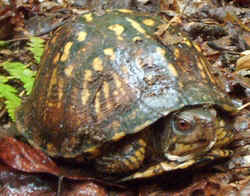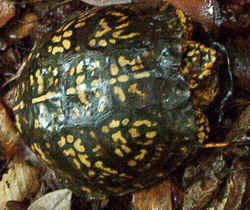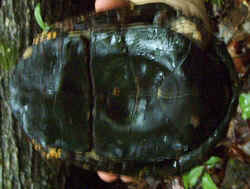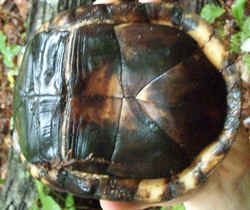 |
 |
|
 |
 |
Eastern Box Turtle
Scientific Name: Terrapene carolina carolina
Family Name: Emydidae
 |
 |
|
 |
 |
Box Turtles: Genus Terrapene These are the "dry-land turtles" that close their shells tightly when danger threatens. Their hallmark is a broad hinge across the plastron, providing movable lobes both fore and aft, these fit so neatly against the upper shell that in many individuals not even a knife blade could be inserted between them. With such close-fitting armor, box turtles are well adapted for a terrestrial life, even though they are much more closely related to some of the water turtles than to the gopher tortoises they superficially resemble. The upper jaw ends in a down-turned beak. In hatchlings -- average 1 1/8 - 1 3/4 inches (2.8 - 3.5 cm) -- the hinge is not functional. The young have a median dorsal ridge, evidences of which may persist in adults. Box turtles, which are strictly North American, range widely over the eastern and central United States and into the Southwest, and they also occur in many parts of Mexico. They are often captured and kept as temporary pets, only to be released well outside their native range. We have not attempted to map such records. As adults, box turtles are kept more frequently as pets than any other turtles. Most adapt themselves readily to captivity, requiring only a backyard or a box of dirt for digging and a shallow pan of water for an occasional soaking. They are omnivorous, and are fond of fruits, berries, and raw hamburger. Canned dog food is a good staple diet. Ages of 30 and 40 years are common, and a few have been reported to reach the century mark. [Conant, Roger and Collins, Joseph T., Peterson Field Guides Reptiles and Amphibians, Houghton Mifflin Company, Boston, 1975]
Eastern Box Turtle: Identification: 4 1/2 - 6 inches. (11.5 - 15.2 cm), record 7 13/16 inches (19.8 cm). A "land turtle" with a high, domelike shell and an extremely variable coloration and pattern. Both upper and lower shells may be yellow, orange, or olive on black or brown; either dark or light colors may predominate. Four toes on each hind foot. Male: Rear lobe of plastron with central concave area; eyes normally brown. Young: Shell much flatter, mostly plain grayish brown, but with spot of yellow on each large scute. Although essentially terrestrial, these turtles sometimes soak themselves by the hour (or day) in mud or water. During hot, dry weather they burrow beneath logs or rotting vegetation, but sharp summer showers usually bring them out of hiding, often in numbers. Similar species: (1) Top of carapace is flattened in Orante Box Turtle. (2) Gopher Tortoises have no plastral hinges. (3) Blanding's Turtle has flatter shell, profusion of light dots, and plastral lobes that don't shut tight. Obese Box Turtles also cannot close tight (thus leaving themselves vulnerable to enemies); but, by pushing down one lobe at a time with the fingers, you can check on whether the closure in the turtle's younger and slimmer days would have been complete. Range: Northeast Massachusetts to Georgia, west to Michigan, Illinois, and Tennessee. Within the United States this and all other races of Terrapene carolina intergrade with one another in most areas where their ranges come in contact; two other races occur in Mexico. [Conant, Roger and Collins, Joseph T., Peterson Field Guides Reptiles and Amphibians, Houghton Mifflin Company, Boston, 1975]